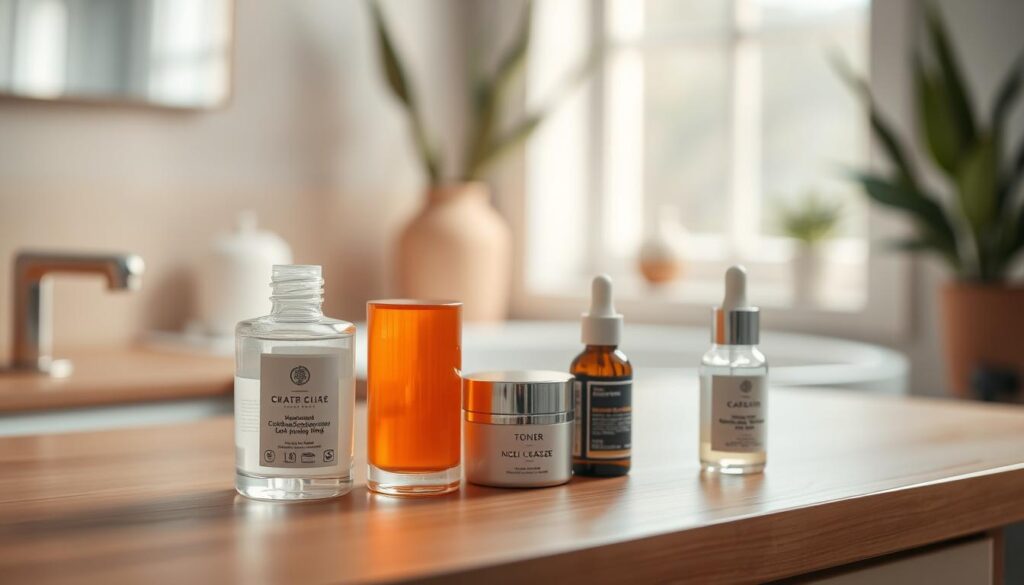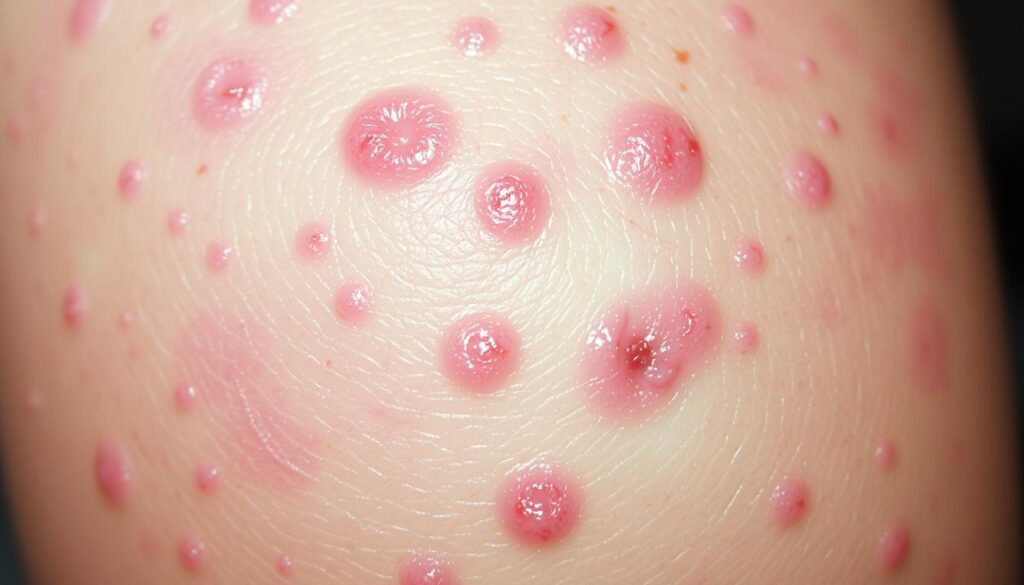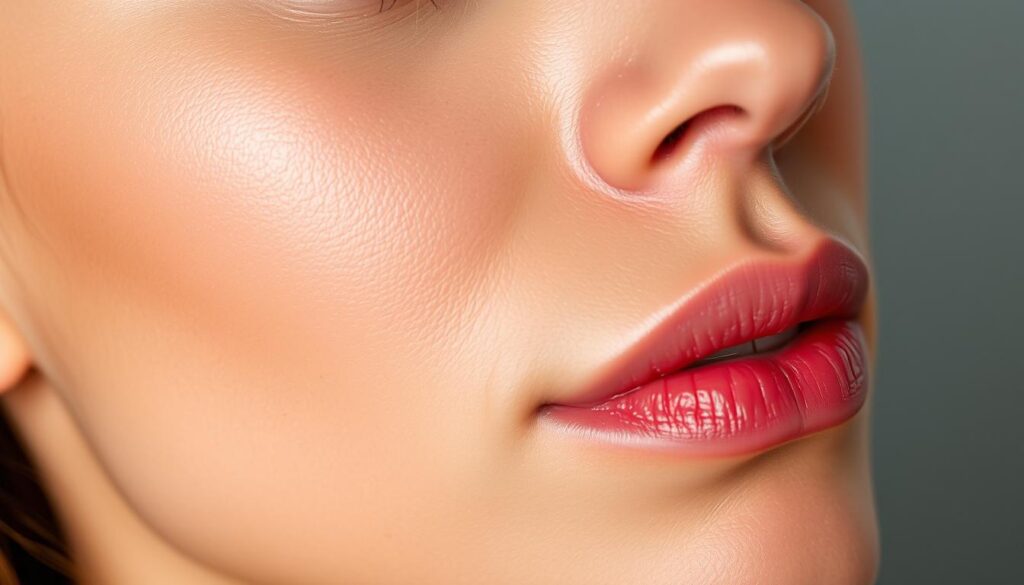Skin conditions like eczema can cause significant discomfort, affecting millions of people worldwide. These conditions often lead to irritation, inflammation, and itching, which can weaken your skin’s natural barrier1. For many, the face is one of the most sensitive areas, requiring special attention to maintain hydration and reduce redness.
Over-washing with harsh soap or detergent can strip your skin of its natural oils, leading to dryness and further irritation2. Studies show that proper care, including moisturizing, can reduce the severity of flare-ups by up to 50%1. This highlights the importance of choosing the right products for your skin type.
Stress and allergens can also exacerbate these conditions, making it essential to identify and avoid triggers. By understanding the basics of skin care, you can take steps to protect your skin and improve your overall well-being.
Understanding Eczema and Facial Skin Sensitivity
Understanding eczema is the first step toward managing its symptoms effectively. This skin condition, also known as atopic dermatitis, affects millions worldwide. It often leads to dryness, itching, and inflammation, especially on sensitive areas like the face3.
What is Eczema?
Eczema is a chronic skin condition that causes patches of dry, itchy, and inflamed skin. There are several types, including atopic eczema and contact dermatitis. Atopic eczema is the most common, often appearing in childhood and persisting into adulthood4.
Contact dermatitis occurs when the skin reacts to irritants like harsh soap, detergents, or allergens. About 80% of cases are caused by exposure to such substances3.
Recognizing Symptoms and Skin Reactions
Common symptoms include redness, rashes, and itching. On the face, these can appear on the eyelids or around the lips. The rash may vary in color, from red to purple or dark brown, depending on your skin tone3.
Irritants like fragrances, essential oils, and certain chemicals can worsen symptoms. That’s why it’s crucial to choose gentle cleansers and avoid harsh products5.
| Symptom | Description |
|---|---|
| Dryness | Patches of flaky or scaly skin |
| Itching | Intense urge to scratch, often worse at night |
| Redness | Inflamed areas that may feel warm to the touch |
| Rash | Discolored patches that may be red, purple, or brown |
Monitoring your symptoms and noting any changes can help you identify triggers. This makes it easier to manage flare-ups and maintain healthy skin4.
Identifying Eczema Triggers and Flare-Ups
Managing flare-ups starts with knowing what sets them off. Triggers can vary from person to person, but some are more common than others. By identifying these, you can take steps to keep your skin calm and healthy6.
Common Irritants and Allergens
Everyday products like soaps, detergents, and makeup can irritate your skin. Ingredients such as fragrances, essential oils, and alcohol are often culprits. Studies show that about 20% to 30% of individuals with this condition react to these substances6.
Nickel-containing jewelry and certain fabrics, like wool and polyester, can also cause issues. Up to 70% of patients report that these materials worsen their symptoms6. Choosing hypoallergenic products and soft fabrics can help reduce irritation.
Environmental and Emotional Stress Factors
Changes in weather, dust, and pet dander are common environmental triggers. Research indicates that 30% of flare-ups are linked to these factors6. Keeping your surroundings clean and using air purifiers can make a difference.
Emotional stress is another major factor. Between 30% and 50% of patients say stress intensifies their symptoms6. Practicing mindfulness or relaxation techniques can help manage this.
By paying attention to these triggers, you can take control of your skin’s health and reduce the frequency of flare-ups.
How to Calm Redness and Itching: Eczema Skincare: How to Calm Redness and Itching
Finding relief from persistent skin discomfort requires a tailored approach. Whether you’re dealing with redness, itching, or inflammation, the right strategies can make a significant difference. Start by understanding what works best for your unique needs.
Strategies for Soothing Inflammation
To soothe inflammation, focus on gentle and effective methods. Use emollients and cream-based treatments to lock in moisture and reduce redness. These products help repair the skin barrier, which is often compromised in such conditions7.
For severe cases, patch-tested topical treatments like steroid creams or calcineurin inhibitors may be necessary. These medications can help reduce symptoms and prevent further irritation8. Always follow the instructions provided by your healthcare provider.
Avoid harsh cleansers and hot water, as they can strip your skin of its natural oils. Instead, opt for mild soaps with a lower pH level to maintain your skin’s balance7.
When to Seek Professional Advice
If your symptoms persist despite using over-the-counter treatments, it’s time to consult a dermatologist. Persistent redness, itching, or discomfort may indicate a need for stronger medication or a different approach8.
Professionals can also help identify triggers and recommend personalized care plans. This ensures you receive the most effective treatment for your specific condition7.
| Treatment | Benefits |
|---|---|
| Emollients | Lock in moisture, reduce redness |
| Steroid Creams | Reduce inflammation, calm itching |
| Calcineurin Inhibitors | Treat severe symptoms, prevent irritation |
| Mild Cleansers | Maintain skin balance, avoid dryness |
By following these strategies, you can manage flare-ups effectively and restore comfort to your skin. Remember, professional guidance is always available if needed.
Establishing a Daily Skincare Routine for Relief
Creating a consistent daily routine can significantly improve your skin’s health and reduce discomfort. For those dealing with sensitive skin, a structured approach helps manage symptoms and prevent flare-ups9. Start with gentle steps that protect your skin’s natural barrier.

Proper Cleansing Techniques
Cleansing is the foundation of any effective routine. Use a mild, soap-free cleanser to avoid stripping your skin of its natural oils. Harsh products can worsen dryness and irritation, especially on sensitive areas like the face10.
Opt for lukewarm water instead of hot showers, as high temperatures can dry out your skin. Limit bathing to 5-10 minutes to maintain hydration9. After washing, pat your skin dry gently with a soft towel.
Moisturizing Tips for Lasting Hydration
Moisturizing is essential to lock in hydration and repair your skin’s barrier. Apply a rich cream or ointment within 3 minutes of bathing to prevent water evaporation9. Products like Cetaphil, Eucerin, or Vaseline are excellent choices for lasting relief.
For best results, moisturize 2-3 times a day, focusing on dry or irritated areas. Emollient-rich formulas can reduce the need for medication and prevent severe flare-ups10. Consistency is key to maintaining healthy skin.
- Use hypoallergenic products to minimize irritation.
- Avoid fragrances and alcohol-based formulas.
- Reapply moisturizer throughout the day, especially on hands.
By following these steps daily, you can manage symptoms effectively and enjoy healthier, more comfortable skin. Always consult a dermatologist for personalized advice11.
Choosing the Right Products for Sensitive Skin
Selecting the right products for sensitive skin can make a world of difference in managing discomfort. Your skin’s health depends on items that are gentle, effective, and free from common irritants. By making informed choices, you can reduce flare-ups and maintain a balanced, healthy complexion12.
Fragrance-Free and Hypoallergenic Options
Fragrances and dyes are among the top culprits for triggering irritation. Opt for fragrance-free and hypoallergenic products to minimize the risk of reactions. These items are specially formulated to be gentle on reactive skin, helping to soothe and protect13.
Look for labels that mention “dermatologist-tested” or “suitable for sensitive skin.” These products are less likely to contain harsh chemicals that can worsen your condition14.
Understanding Product Ingredients and Labels
Reading labels is essential to avoid ingredients that may irritate your skin. Avoid retinoids, essential oils, and alcohol, as these can strip moisture and cause dryness12. Instead, focus on ingredients like ceramides and hyaluronic acid, which help restore your skin’s natural barrier14.
For prolonged symptom relief, consider products with calcineurin inhibitors. These medications can reduce inflammation and itching, especially for those with chronic conditions13.
- Choose fragrance-free cleansers to avoid stripping natural oils.
- Look for hypoallergenic creams to lock in moisture.
- Avoid products with alcohol or essential oils.
By selecting the right products, you can maintain balance in your skin and reduce flare-ups. Always consult a dermatologist for personalized advice14.
Incorporating Lifestyle and Stress Management Practices
Managing your daily habits can play a crucial role in reducing skin discomfort and improving overall well-being. Emotional stress is a known trigger for flare-ups, with studies showing that 50% of individuals report worsened symptoms during stressful periods15. By adopting mindfulness and relaxation techniques, you can create a healthier balance for both your mind and your skin.
Mindfulness and Relaxation Techniques
Practicing mindfulness can help you stay grounded and reduce stress. Techniques like deep breathing, meditation, and progressive muscle relaxation are effective ways to calm your mind. These methods not only improve mental clarity but also help prevent flare-ups by lowering stress levels15.
Start with just 5-10 minutes a day. Find a quiet space, focus on your breath, and let go of tension. Over time, these practices can become a natural part of your routine, supporting both your emotional and physical health.
Creating a Calming Nighttime Ritual
Your nighttime routine can significantly impact your skin’s health. Use gentle, oil-based creams to lock in moisture and soothe irritation. Applying these products before bed helps repair your skin barrier overnight15.
Dim the lights, avoid screens, and engage in calming activities like reading or listening to soft music. This prepares your body for restful sleep, which is essential for managing symptoms and maintaining balance.
| Technique | Benefits |
|---|---|
| Deep Breathing | Reduces stress, calms the mind |
| Meditation | Improves focus, lowers anxiety |
| Progressive Muscle Relaxation | Relieves tension, promotes relaxation |
| Nighttime Cream Application | Repairs skin barrier, soothes irritation |
By incorporating these practices into your day, you can manage stress more effectively and support your skin’s health. Remember, small changes can lead to significant improvements over time.
Food Triggers and Environmental Factors That Impact Your Eczema
Your diet and environment play a significant role in managing skin health, especially for those with sensitive skin. Certain foods and external factors can act as triggers, leading to discomfort and flare-ups. Understanding these influences can help you take proactive steps to maintain balance and reduce irritation.
Identifying Dietary Triggers
Certain foods are known to worsen symptoms for many individuals. Dairy, gluten, and processed items like white flour products are common culprits16. Nightshades, such as tomatoes and peppers, may also contribute to flare-ups in some cases16.
Research suggests that an elimination diet could reduce the severity of symptoms for some people16. Foods high in vitamin C, like oranges and broccoli, may help reduce nickel absorption, which can be beneficial16. Probiotic-rich options, such as yogurt, might also provide relief by supporting gut health16.
- Avoid ultra-processed foods and dairy if they trigger your symptoms.
- Incorporate anti-inflammatory options like fruits, vegetables, and healthy fats.
- Consider a Mediterranean diet, which emphasizes whole foods and limits processed items16.
Managing Weather and Fabric Irritants
Environmental factors like low humidity or harsh weather can worsen your condition16. Dry air strips moisture from your skin, leading to increased irritation. Using a humidifier during colder months can help maintain hydration levels.
Fabrics also play a role. Wool and polyester are common irritants, while breathable materials like cotton are gentler on your skin16. Choosing hypoallergenic bedding and clothing can reduce the risk of flare-ups.
By monitoring your diet and environment, you can identify specific triggers and make adjustments to support your skin’s health. Small changes can lead to significant improvements over time.
Conclusion
Taking control of your skin’s health starts with understanding its unique needs. A consistent, gentle routine can reduce irritation and keep your face calm. Avoiding triggers like harsh fragrances or environmental allergens is key to preventing flare-ups17.
When symptoms persist, consulting a dermatologist ensures you receive personalized care. Treatments like calcineurin inhibitors or tailored plans can make a significant difference18. Remember, small changes in your daily habits can lead to lasting improvements.
By staying proactive and mindful of your skin’s condition, you can achieve a healthier, more comfortable life. Start today and embrace the steps that work best for you.



